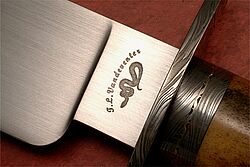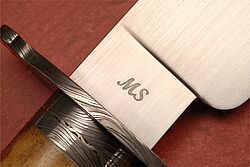
What is an ABS Master Smith?
In 1976 the American Bladesmith Society (ABS) was conceived with the goals of preserving and furthering the art and science of the forged blade. It was decided that some sort of guidelines should be implemented for the testing, advancement and subsequent ranking of bladesmiths within the ranks of the ABS.
Many knife makers advertised themselves as "masters" but until this time there was no formal system for officially awarding such a title. So, the titles of Apprentice, Journeyman (JS), and Master (MS) were adopted, and testing requirements were established for the last two. Any ABS member in good standing may test for rank, but no one is ever required to. Testing is in two parts.
An Apprentice Smith wishing to test for Journeyman must appear before an ABS Master Smith with a blade designed for a physical, destructive test. This test which involves several cutting, bending and edge-holding trials is meant to determine the smith's ability to effectively forge and heat-treat steel to produce a functional blade. Later at the yearly meeting of the ABS, the smith must present this bent test blade along with five completed knives representing his finest work. Seven Master Smiths will judge the work and vote on the outcome.
After an established waiting period, a Journeyman may decide to test for advancement to the level of ABS Mastersmith. The functional test is the same as for JS except that the blade must be made from 300 layer minimum pattern welded steel (damascus). The blade must cleanly sever a free-hanging 1" diameter hemp rope within four inches of the end, chop two 2X4 pine studs in half, and in the end, shave hair from the applicant's arm to show edge-retention. Finally the blade is placed in a vice and bent ninety degrees without breaking or delaminating.
At the annual meeting of the ABS, the applicant must present the bent damascus knife plus five additional completed examples of his work. These knives must reflect the utmost in design, ergonomics, fit and finish. They should be the finest knives the applicant has made up to that time. One of the five knives must be a European Quillion Dagger with 300 minimum layers of damascus steel, a carved fluted handle and twisted wire inlay.
In 2006 six ABS Master Smith judges unanimously promoted me to Mastersmith, bringing the total number of ABS Masters worldwide to 113. I am the first ABS Master Smith from the state of Mississippi.

